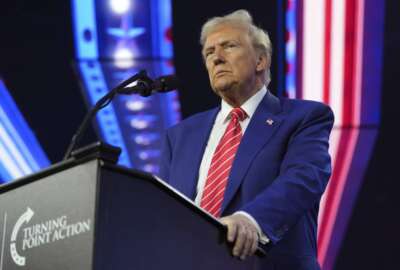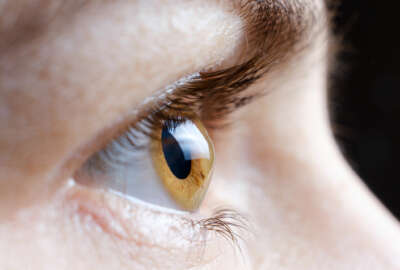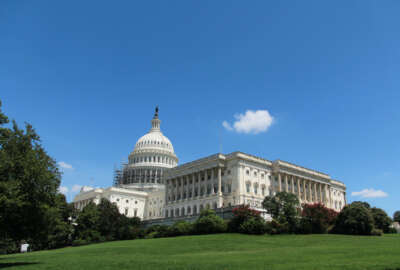Military will support inauguration with 13,500 personnel
Military personnel will have a role both in the inaugural parade itself and providing security and support around the hundreds of thousands of people who will...
wfedstaff | April 17, 2015 4:28 pm
After months of planning, the military is putting the final touches on its preparations for next month’s presidential inauguration, and both National Guard and active duty units are planning a huge presence.
The military does not have the lead role in either planning the inauguration or providing security — that lies with the Presidential Inauguration Committee, the Secret Service and D.C. Metropolitan police.
But the supporting role of the military services is huge, and it’s grown significantly in recent years, said Maj. Gen. Errol Schwartz, the commanding general of the D.C. National Guard.

“Our soldiers and airmen have done this quite a few times,” he said. “Prior to 2005, the D.C. National Guard did this all by themselves. In 2005, we brought in 120 folks. In 2009, we brought in 7,000. It’s a varying number, so you have to tweak your plans, making sure every [service member] who comes into the city is registered through our process and processed out so we can account for every individual and piece of equipment.”
This year, the D.C. Guard is bringing in about 6,000 guardsmen and women from several states and territories. DoD will add to that force about 7,500 more active duty troops from the Army, Navy, Air Force, Marines and Coast Guard.
“They’ll go out to several parts of the city, but they’ll be housed close to the ceremonies so they can walk to their missions because of the crowd that we’ll be working with,” Schwartz said.
Many roles in the ceremony
The military personnel will have a role both in the inaugural parade itself and providing security and support around the hundreds of thousands of people who will descend on the National Mall on Jan. 21.
Around 1,500 service members from ceremonial units will participate in the parade. The rest will have specific duties as part of quick reaction forces, chemical, biological, radiological and nuclear response forces, manning communications platforms and providing medical assistance and directing traffic.
Maj. Gen. Michael Linnington, the commander of the military’s Joint Task Force-National Capital Region, the command that’s responsible for handling DoD’s inaugural support, said those forces will be well prepared. But he still has one big worry.
“Ceremonially, for me, it’s weather,” he said. “When you look at safety and force protection of your ceremonial units, if it’s bitter cold and snowing, things get more complicated.”

Most of the military units supporting the inauguration won’t arrive in downtown D.C. until just before the event, but DoD has increased the Joint Task Force’s staff by several hundred people to help plan and prepare. Coordinators are running drills using a huge scale map of downtown Washington on the floor of a gymnasium at the D.C. Armory, literally walking through the steps each unit will take on inauguration day.
“Along with that, on the overhead, they have a time sequence that shows what’s going on while they’re walking and talking,” Linnington said. “The military does rehearsals better than anybody. So while folks are walking along the routes, they can see the effect of what’s going on. It’s a very good tool for synchronizing events in time and space. That’s one of about 15 or 20 more rehearsals we’ll do between now and the 21st, including a full force rehearsal about a week before the event. It’s an important event for us to do right in front of the eyes of the world.”
A live ballet
Although there’s a lot of planning activity happening now, the idea is that no one in D.C. will notice much going on until the eve of inauguration day and on the day itself, when military units and civilian agencies start last minute preparations, such as removing each and every traffic light from Pennsylvania Ave., and begin staging thousands of marchers, horses and floats at the beginning of the parade route.
“That’s quite a ballet when you think about it,” said Brig. Gen. James Scanlon, the deputy commander of the joint task force. “The reviewing stand in front of the White House is already under construction, the stand on the West Capitol Front is already under construction, but in the wee hours of the morning before the inauguration, that’s when the final details will come together, like the warming tents for the participants and the bike racks and the road barriers.”
Planners say they’re trying to learn lessons from the 2009 inauguration, when a record 1.8 million people came to see President Barack Obama’s first inauguration. For example, the Third Street tunnel will be completely closed to pedestrians and traffic on inauguration day. Four years ago, the underground structure earned the unfriendly nickname “Purple Tunnel of Doom” when thousands of people with tickets to enter the inauguration’s purple gate were trapped for hours underground and missed the ceremony.
RELATED STORIES:
Corporate money to help pay for Obama inauguration
Obama to kick off inauguration with day of service
Copyright © 2024 Federal News Network. All rights reserved. This website is not intended for users located within the European Economic Area.
Jared Serbu is deputy editor of Federal News Network and reports on the Defense Department’s contracting, legislative, workforce and IT issues.
Follow @jserbuWFED






